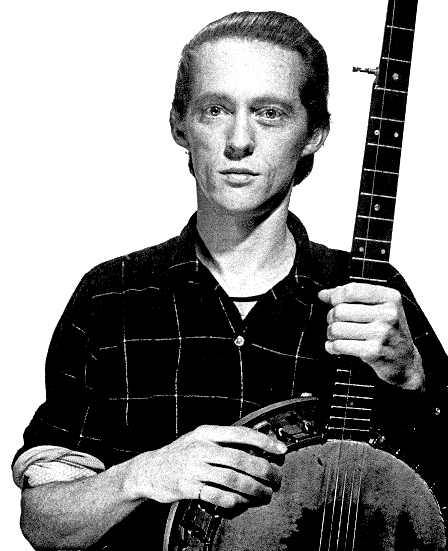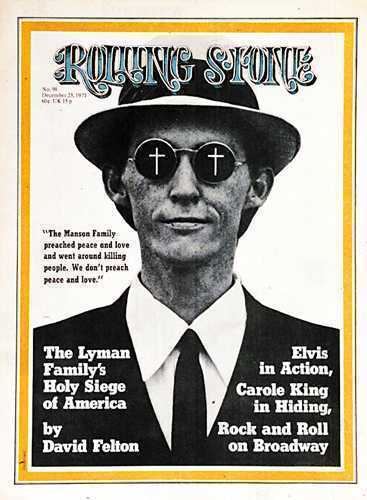Name Mel Lyman Role Musician | Died March 1978 Albums American Avatar | |
 | ||
Occupation MusicianLeader, The Lyman Family Similar People Jim Kweskin, Lisa Kindred, Geoff Muldaur, Maria Muldaur, Eric Von Schmidt | ||
Mel lyman rock of ages
Melvin James Lyman (March 24, 1938 – March 1978) was an American musician, writer, and founder of the Fort Hill Community, which has been variously described as a family, commune, or cult.
Contents
- Mel lyman rock of ages
- Mel lyman birth track 1
- Early life
- Musician
- Writer
- The Lyman Family The Fort Hill Community and the Avatar
- Later developments and Lymans death
- Publications
- Discography
- References

Mel lyman birth track 1
Early life

Lyman grew up in California and Oregon. As a young man, according to the music newsletter The Broadside of Boston, he spent a number of years traveling the country and learning harmonica and banjo from such musicians as Brother Percy Randolph and Obray Ramsey.
During a period in the early 1960s, Lyman lived in New York City, where he associated with other artists, filmmakers, musicians and writers. An example of which was his friendship with underground filmmaker Jonas Mekas, which led to the studios of Andy Warhol and Bruce Conner. He learned the art of filmmaking from Conner and made some films with him.
Musician
In 1963 Lyman joined Jim Kweskin’s Boston-based jug band as a banjo and harmonica player. Lyman, once called "the Grand Old Man of the 'blues' harmonica in his mid-twenties", is remembered in folk music circles for playing a 20-minute improvisation on the traditional hymn "Rock of Ages" at the end of the 1965 Newport Folk Festival to the riled crowd streaming out after Bob Dylan’s famous appearance with an electric band. Some felt that Lyman, primarily an acoustic musician, was delivering a wordless counterargument to Dylan’s new-found rock direction. Irwin Silber, editor of Sing Out Magazine, wrote that Lyman’s "mournful and lonesome harmonica" provided "the most optimistic note of the evening".
Writer
In 1966, supported and funded by Jonas Mekas, Lyman published his first book, Autobiography of a World Savior, which set out to reformulate spiritual truths and occult history in a new way. In 1971, Lyman published Mirror at the End of the Road, derived from letters he wrote during his formative years, starting in 1958 from his initial attempts to learn and become a musician, through the early 1960s as his life widened and deepened musically and personally. The last entries are from 1966 which simply express the profound joys and deepest losses which defined and gave his life direction and meaning in the years ahead. The key to the book and the life he lived afterwards are stated simply in the dedication at the beginning "To Judy who made me live with a broken heart".
The Lyman Family, The Fort Hill Community and the Avatar
It was his relationship with Judy Silver which brought him to Boston in 1963. Again, Lyman became acquainted with many artists and musicians in the vibrant Boston scene, including Timothy Leary's group of LSD enthusiasts, International Foundation for Internal Freedom (IFIF). Lyman was involved for a very short time and, against his wishes, so was Judy. Knowing LSD’s power, he felt she was not ready but stated "the bastards at IFIF gave her acid … I told her not to take it. I knew her head couldn't take it." Lyman’s fears turned out to be justified and she left college and returned to her parents in Kansas. According to one of the anonymous sources interviewed by David Felton for Rolling Stone, "Judy got all fucked up – this is his second old lady – I mean like she got really twisted. I don't know if it was the acid or the scene or whatever, but she split. She went back to Kansas. She was totally out of the picture by the summer of 1963. Judy is probably the most important thing in Mel's life. He worshipped Judy, really loved her. Then she split, you know? She couldn't help it, she was totally freaked out. They took her away." Lyman was by all accounts very charismatic and later, after Judy had left, a community or family naturally tended to grow up around him. At some point thereafter Lyman began to realize himself as destined for a role as a spiritual force and leader.
In 1966, Lyman founded and headed The Lyman Family, also known as The Fort Hill Community, centered in a few houses in the Fort Hill section of Roxbury, then a poor neighborhood of Boston. The Fort Hill Community, to observers in the mid-to-late Sixties, combined some of the outward forms of an urban hippie commune with a neo-transcendentalist socio-spiritual structure centered on Lyman, the friends he had attracted and the large body of his music and writings. Members of Lyman's Community briefly included the young couple Mark Frechette and Daria Halprin, two non-actors who had been discovered and cast by Italian director Michelangelo Antonioni for the lead roles in his second English-language feature, the 1970 film Zabriskie Point. Michael Kindman, founder of the East Lansing underground newspaper The Paper, briefly worked on Avatar and remained with the group for five years. He later wrote of his experiences in his book My Odyssey Through the Underground Press. Journalist and poet Paul Williams, founder of Crawdaddy rock magazine and author of Das Energi, spent a few months on Fort Hill. He told David Felton he had had to escape under cover of darkness after being told he would not be allowed to leave.
Although Lyman and the Family shared some attributes with the hippies – prior experimenting with LSD and marijuana and Lyman’s cosmic millennialism – they were not actually hippies; in fact, the ethos of the community was virulently anti-hippie. Female members dressed and behaved conservatively and male members wore their hair relatively short by the standards of the era. According to both Felton and Kindman, Lyman discouraged sexual activity and at least once ordered a pregnant member to get an abortion. Couples were discouraged from spending private time together. Women were expected to be obedient and serve in domestic capacities only, while men were expected to dominate and control them. Members turned over whatever money they had to the Family. Funds were used to purchase houses in the Fort Hill area for members to live in, construction tools and vehicles along with sound and video recording equipment for Lyman's use. The community's primary activity was construction and remodeling work. The foremost goal was to provide a supportive environment for Lyman to do his creative work.
According to both Felton and Kindman, a macho, bullying ethic prevailed and guns were frequently brandished. Lyman seemed to believe that one could only be truly creative when one was "real" or "awake" – defined in practice as experiencing intense pain or anger – and that fear and cowardice caused one to remain "asleep" or even to die. People were subjected to rigid discipline and highly structured lives.
By the Spring of 1967 the Fort Hill Community had become an established presence in Boston and it, along with members of the wider community in greater Boston and Cambridge, came together to create and publish the Avatar. It contained local news, political and cultural essays, commentary and more personal contributions, writing and photography, from various members of the Fort Hill Community including Lyman. The paper and magazine set new standards in content and design later adopted by more mainstream publications.[citation needed] Throughout the first year of its existence it created what became a national audience and many more people visited Fort Hill at that time, some eventually staying and becoming part of the community.
Rather than the gentle and collectivist hippie ethic in other underground publications of the time, Lyman’s writing in Avatar espoused a philosophy that contained, to some readers of the time, strong currents of megalomania and nihilism and to others a powerful alternative voice to the prevailing ethos.
After working very intensely on each issue, in the Spring of 1968 the Family gained complete editorial control of Avatar for the final issue of the paper. Later they founded their own magazine, American Avatar which continued the editorial directions of the newspaper. Lyman’s writings in these publications brought increased visibility and public reaction both pro and con. His writings, along with others in the publications, could be poetic, philosophical, humorous and confrontational, sometimes simultaneously, as Lyman at various times claimed to be: the living embodiment of Truth, the greatest man in the world, Jesus Christ, and an alien entity sent to Earth in human form by extraterrestrials. Such pronouncements were typically delivered with extreme fervor and liberal use of ALL CAPS.
Later developments, and Lyman’s death
On The Dick Cavett Show in 1970, Mark Frechette said Lyman's group was not a commune: "It's a 'community', but the purpose of the community is not communal living. ... The community is for one purpose, and that's to serve Mel Lyman, who is the leader and the founder of that community."
In 1971, Rolling Stone magazine published an extensive cover exposé on the Family by associate editor David Felton. The Rolling Stone report described an authoritarian and dysfunctional environment, including an elite "Karma Squad" of ultra-loyalists to enforce Lyman’s discipline, the Family's predilection for astrology, and isolation rooms for disobedient Family members. Family members disputed these reports, but ex-members corroborated much of them, especially Michael Kindman in My Odyssey Through the Underground Press.
The Rolling Stone article and the earlier trial of Charles Manson, who seemed to share some traits in common with Lyman, raised the Family’s profile and – whether fairly or not – established Lyman in the public mind as a bizarre and possibly dangerous person.
However, in 1973, members of the Family, including Frechette, staged a bank robbery. One member of the Family was killed by police, and Frechette, sentenced to prison, died in a weightlifting accident in jail in 1975.
Unlike the Manson Family, Lyman’s did not explode in a dramatic denouement. Rather, the Family took a lower profile and carried on, quietly building on the relationships formed in the turbulent early years. Lyman died in 1978, age 40; the location and cause of death has not been publicly revealed.
After Lyman’s death, the Family evolved into a smaller, more conventional extended family. The skills acquired in refurbishing the structures of the Family compound led to the founding of the Fort Hill Construction Company. Although some former Family members have rejected Lyman, current members still revere him.
